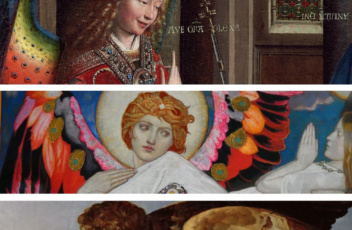20 Famous Paintings of Angels & more
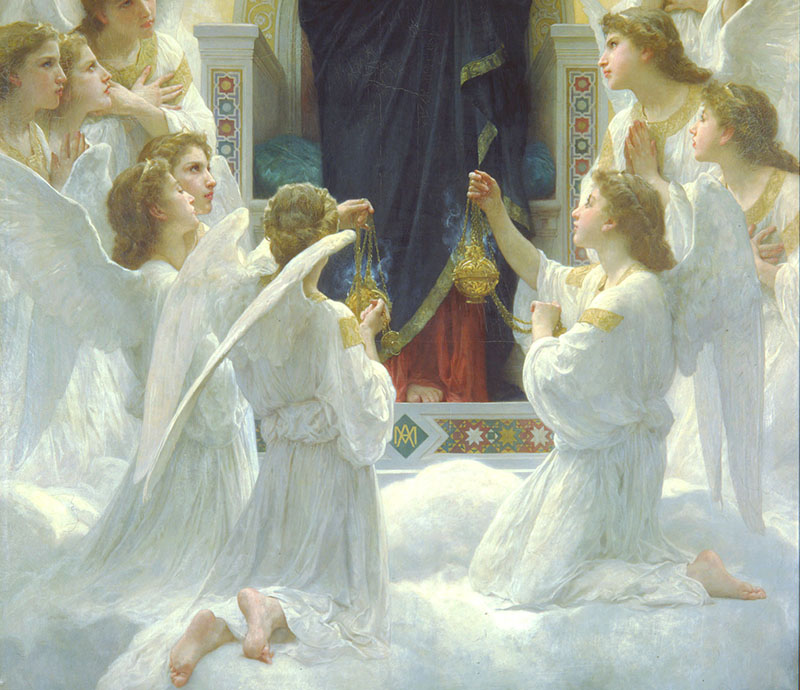
In this article I’d like to share some of the most beautiful paintings of angels created throughout art history and why I love every one of them! But first, let’s talk about the hierarchy of angels.
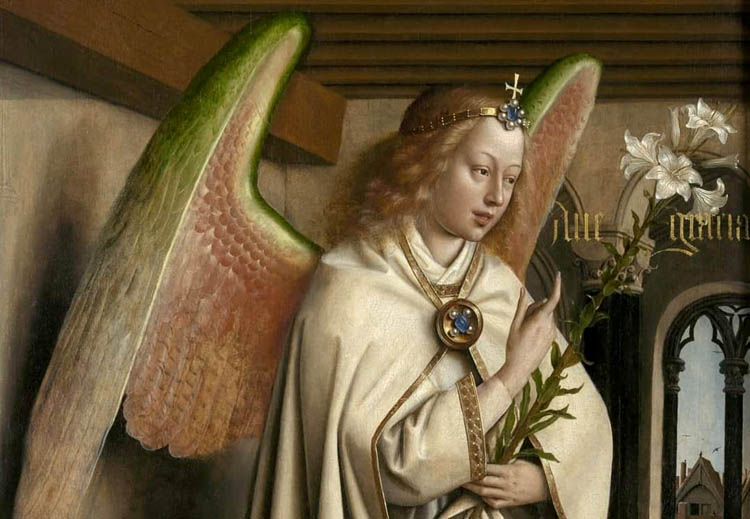
Hierarchy of Angels
Believe-it-or-not, angels also have their hierarchy! At least that’s how the Church saw them painted throughout art history. In large scale paintings many angels were often painted in tiers while there is only one archangel Gabriel who appears to the virgin Mary in the “Annunciation” paintings. There are a lot of Annunciation paintings! The angel comes down to announce that Mary is going to be pregnant with Christ. He carries the white lily that symbolizes Mary’s purity.
There are 9 rows /orders of angels painted in tiers. according to Joost Joustra who decodes paintings of angels in a video at the National Gallery of Art in London ( https://www.nationalgallery.org.uk/stories/a-curated-look-angels?utm_source=wordfly&utm_medium=email&utm_campaign=NG_2020June_Newsletter_NM&utm_content=version_A ) The very bottom tier consists of angels, then archangels, and principalities. They have human form and become the messengers to humans. The second tier consists of powers, virtues and the dominions. The third, top tier consists of baby-like angels – thrones, cherubims, and seraphims that often surround Mary and Christ in Heaven. (Source: National Gallery, London)
Bermejo (1440-1498), Spanish (Jewish)
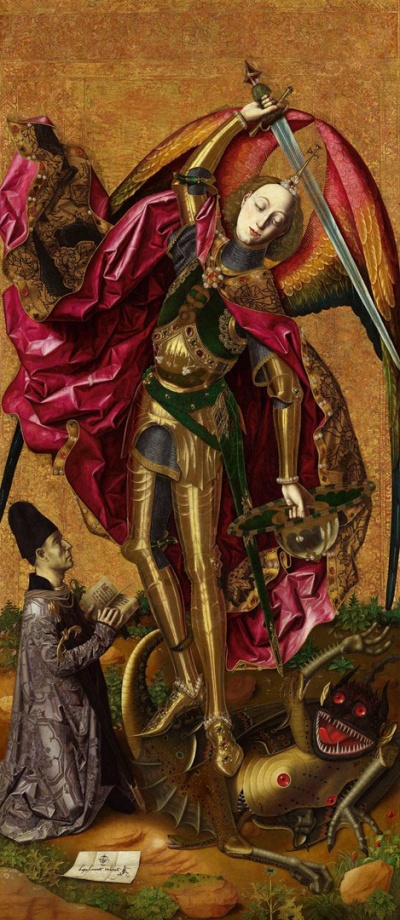
1468, the National gallery, London
Bermejo was one of the most influential painters in the 15th century Spain and very few works are known to exist to our day. Recently restored, this beautiful painting is on view at the National Gallery of Art in London.
Archangel Michael wears golden suit of shiny tournament armor decorated with beautiful jewels. Realistically painted precious stones, fabric textures, incredible details, angel’s scale and colorful wings clearly show the influence of the Netherlandish artist Jan van Eyck (one of the artists shown below).
Bermejo conveys slender St. Michael jumping into action to defeat the Devil. Realistically painted, bright, floating fabric crosses the picture at a diagonal to create movement. Calm, stylized face has the female features – full, red lips, soft jawline and thin, round eyebrows.
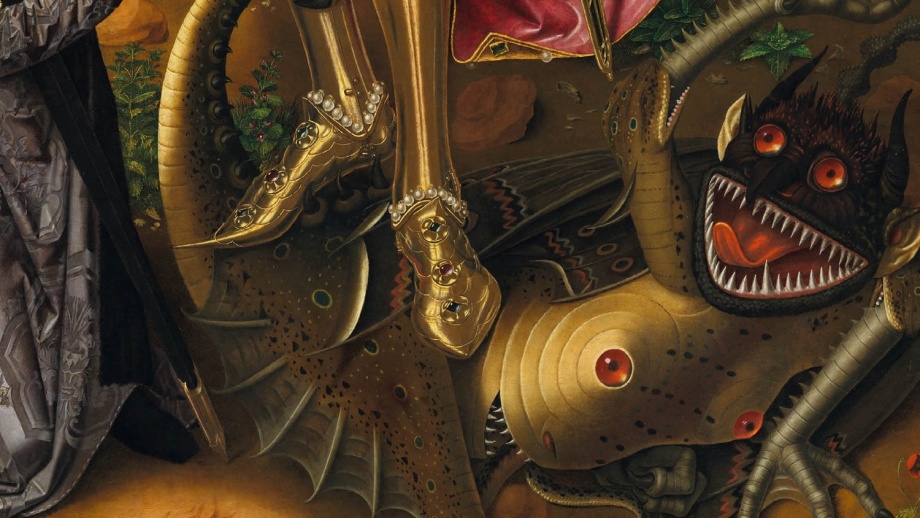
When we stop staring at the incredible armor boots decorated with pearls and precious stones, we turn our gaze to the red-eyed monster that consists of different animal parts – a second face body, snakes, reptilian heads and tail, butterfly wings and bird-like back legs. These wings suggest that the monster is a fallen angel.
Fra Filippo Lippi (1406-1469), Italian
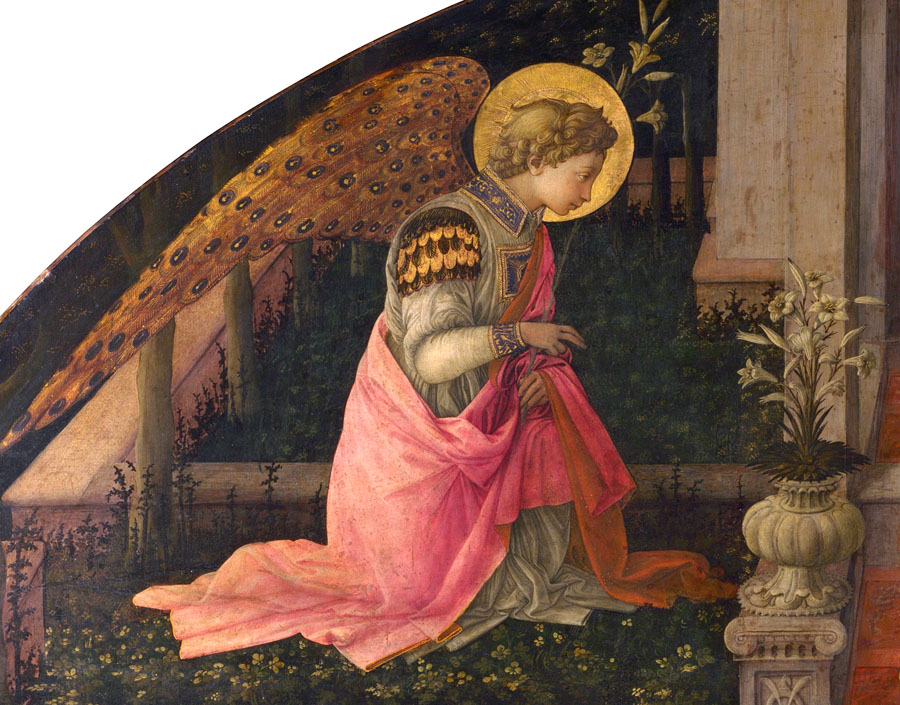
The friar lived in a monastery all his life and painted Christian imagery for the churches and prominent families in Italy. This painting was commissioned by the Medici family to hang in their palazzo in Florence. What I love about this painting is the angel’s peacock feather wings. Beautiful black-gold feathers appear on the angel’s shoulders as well. Gabriel is a boy in this painting.
We often see the white lily in the Christian art paintings as these flowers represent the Virgin Mary’s purity who ascended into the Heaven.
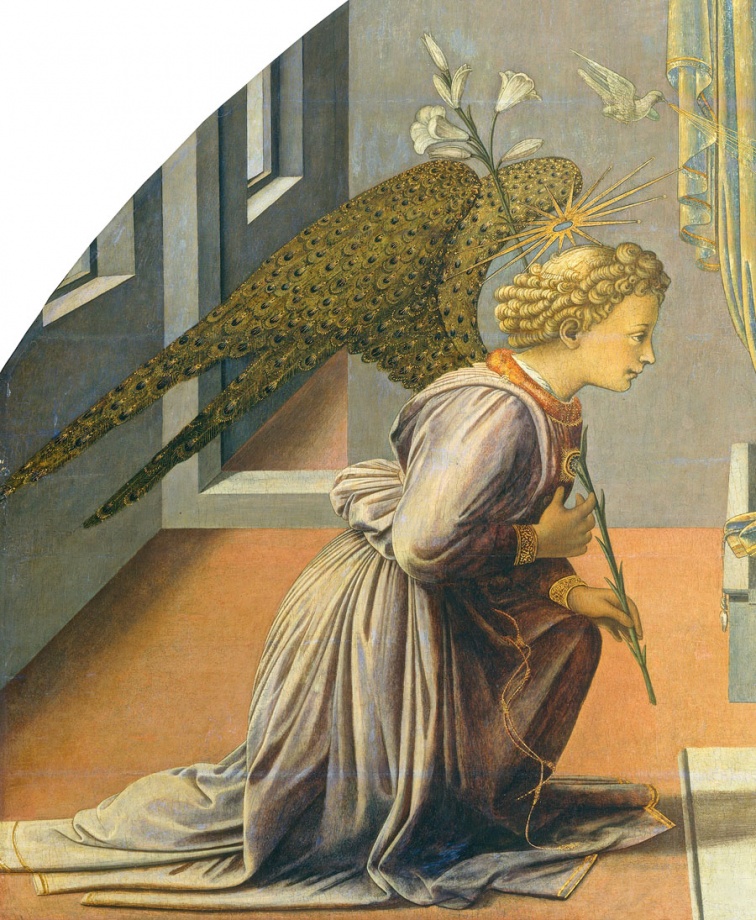
Here is another painting’s close up of the angel painted by Lippi. The face looks less naturalistic but the peacock feather wings are super detailed.
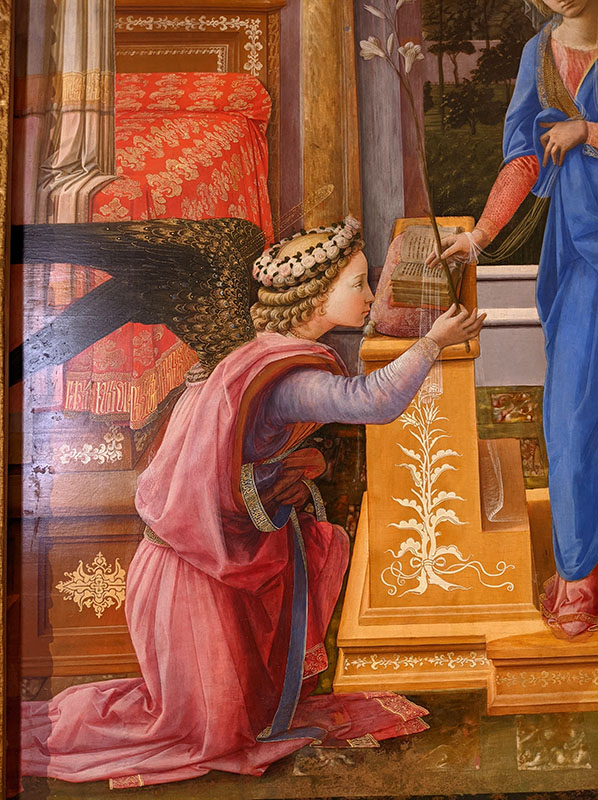
Fra Angelico (1395 –1455), Italian
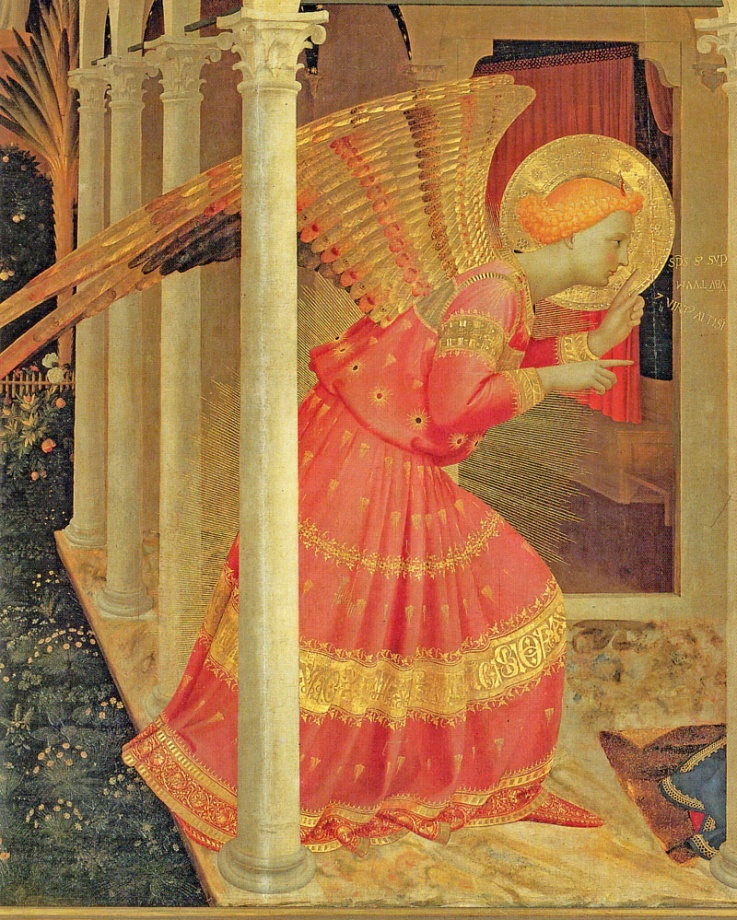
Fra Angelico was a Dominican friar who created altarpieces in Cortona, Florence and other towns in Italy. “Angelic” was his nickname for high moral virtues he exhibited in his daily life. Influenced by the classical school of altar painting, his iconic-like figures are wrapped up in beautiful fabrics with golden accents. This angel is frozen in action thrusting forward to deliver the message. Colorful wings, golden words and the halo celebrate the divine nature of the figure.
Michelangelo Caravaggio (1571–1610), Italian
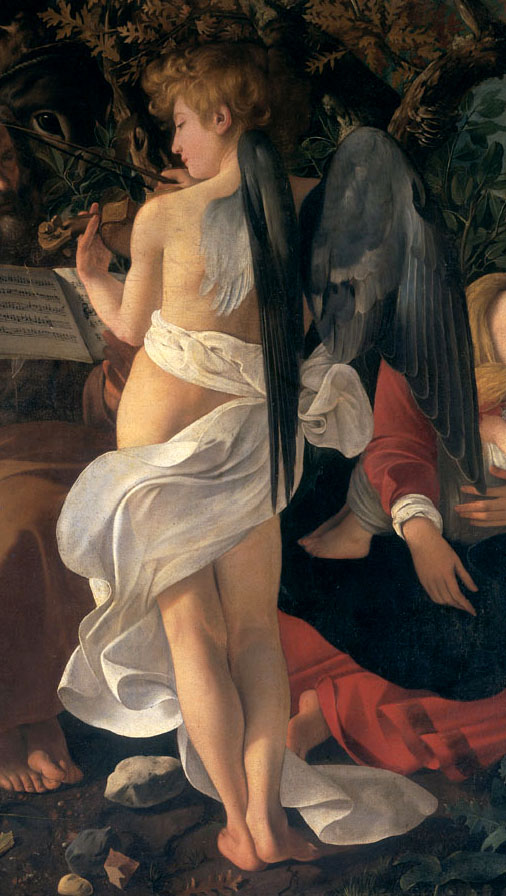
The Italian Baroque artist was a highly influential painter who left incredible artistic legacy. Caravaggio is responsible for the creation of an entirely new movement after his death – the ‘candle light painters.’ Caravaggio began his career as a very poor young man but he quickly rose to prominence painting for the royalty and the wealthy in Rome and beyond.
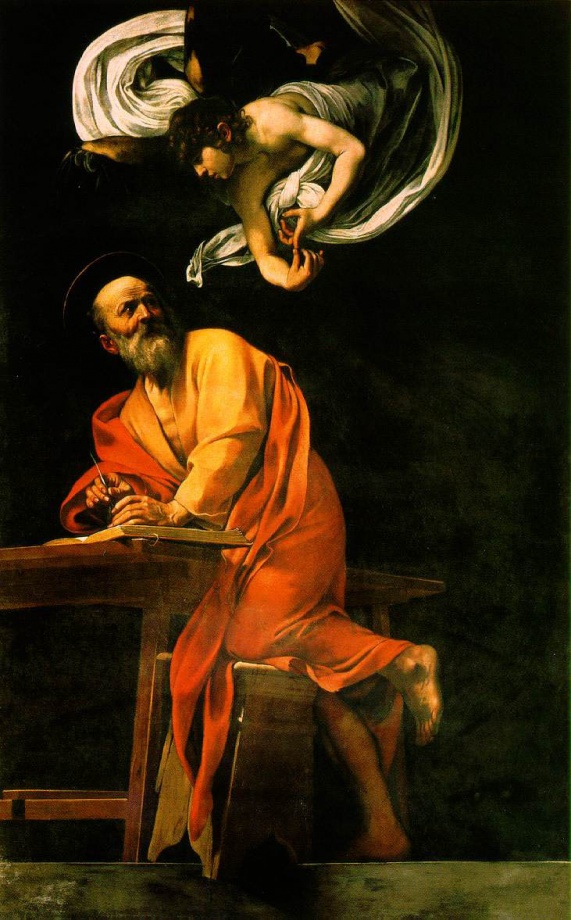
The artist was the innovator on so many levels using regular, often poor people as his models to depict stories from the Bible. His beautiful paintings have innovative compositions, high contrast, and naturalism. Caravaggio painted realistically, showing strong anatomy drawing skills. Look at the perfect contour lines of the legs and arms! The artist mastered human facial expressions as well as the light in perfectly-painted skin tones. And the angels’ wings look as real as the ones of a bird. In his paintings, fluid fabric creates movement, visual interest, and balance.
Jan van Eyck (1390-1441), Belgium
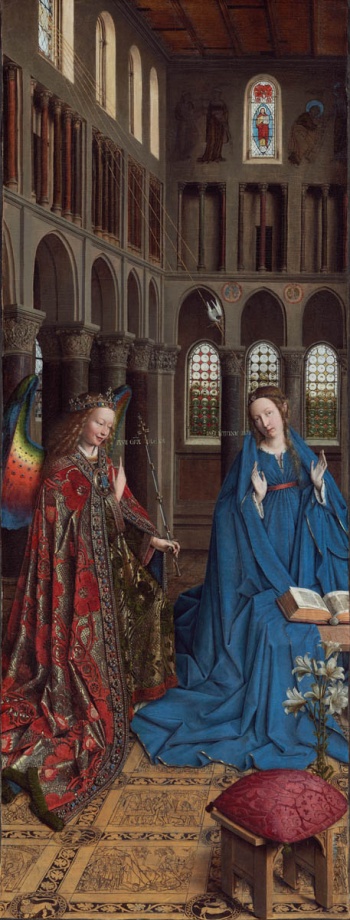
The Netherlandish artist (currently Belgium) Jan van Eyck is one of my favorite painters. This painting was part of a triptych and carries a lot of symbolism recorded in the interior space of the church. (Read about this painting here: https://www.nga.gov/collection/art-object-page.46.html )
While the artist’s figures are often out of scale in comparison to the architecture, and his use of linear perspective is intuitive, van Eyck’s incredible realism of painted textures and faces is fantastic! I learned a lot from his work studying painted jewelry, fabric, and other details. He is the greatest artist of late Gothic Northern Europe.
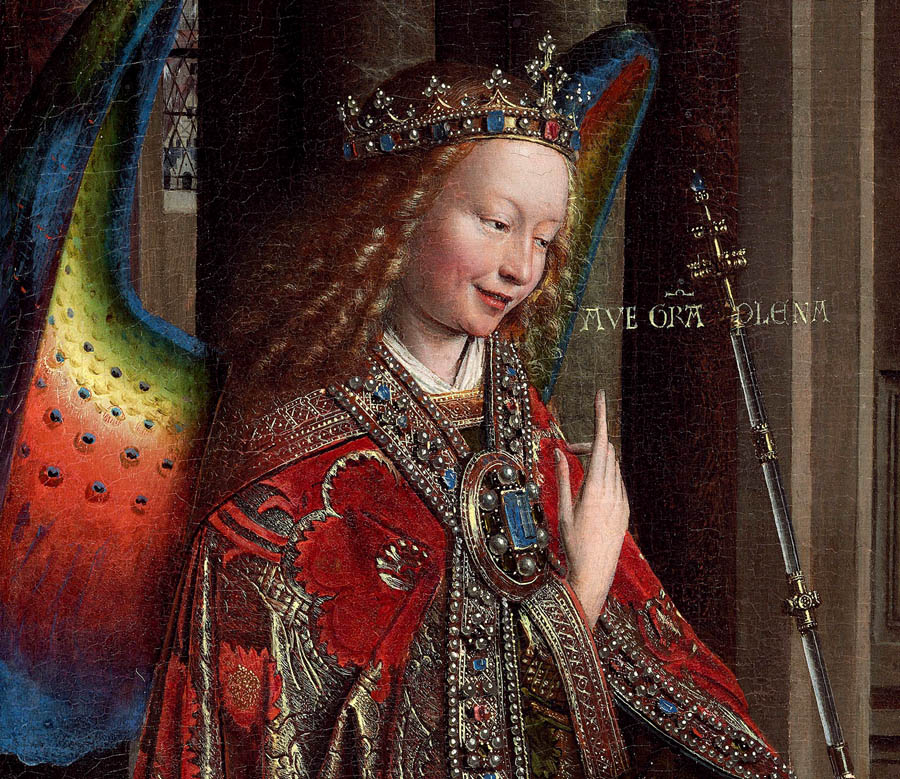
The archangel wears an elaborate crown and bright red attire matching the ornate quality of colorful wings. Notice that Gabriel smiles delivering his message to Mary, which is quite unusual.
Leonardo da Vinci (1452-1519), Italian
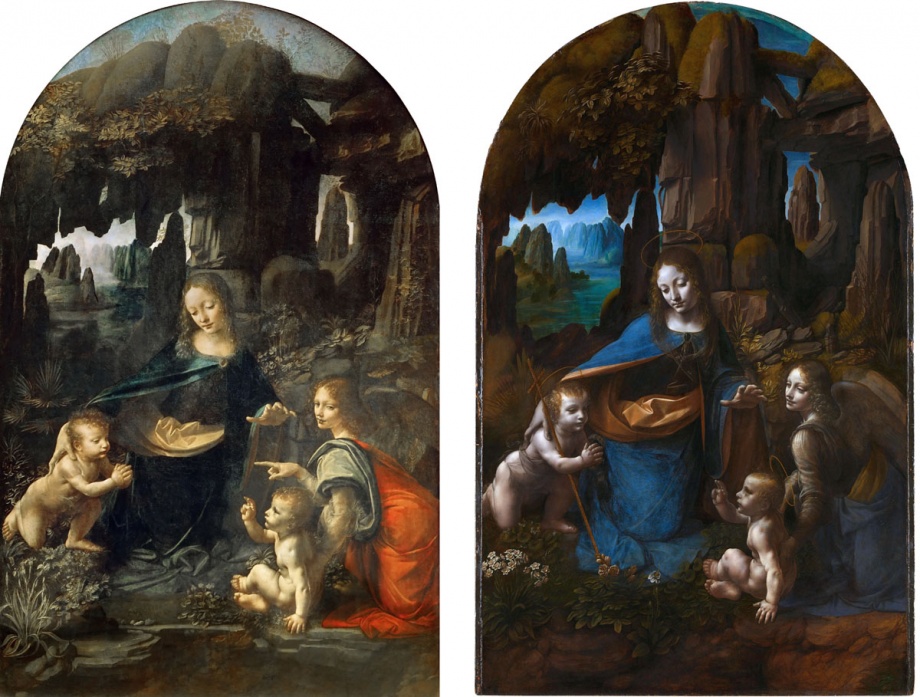
The Virgin of the Rocks (1483–1486 & before 1508) are two variants of similar paintings displayed in London and Paris. They do differ in many ways including how they were painted. Also in the Louvre painting the angel’s hand points at St. John the Baptist.
In the London version (right) the top color layers of paint wore of of their faces revealing a lot of black-and-white painting (underpainting). That’s why the angel in particular lacks the vibrancy of colors painted in greys and browns. Only his cloak reveals some blue-yellow hues. Yet the angel looks absolutely stunning and ethereal. This is fascinating because you can reverse-engineer the da Vinci’s oil painting technique.
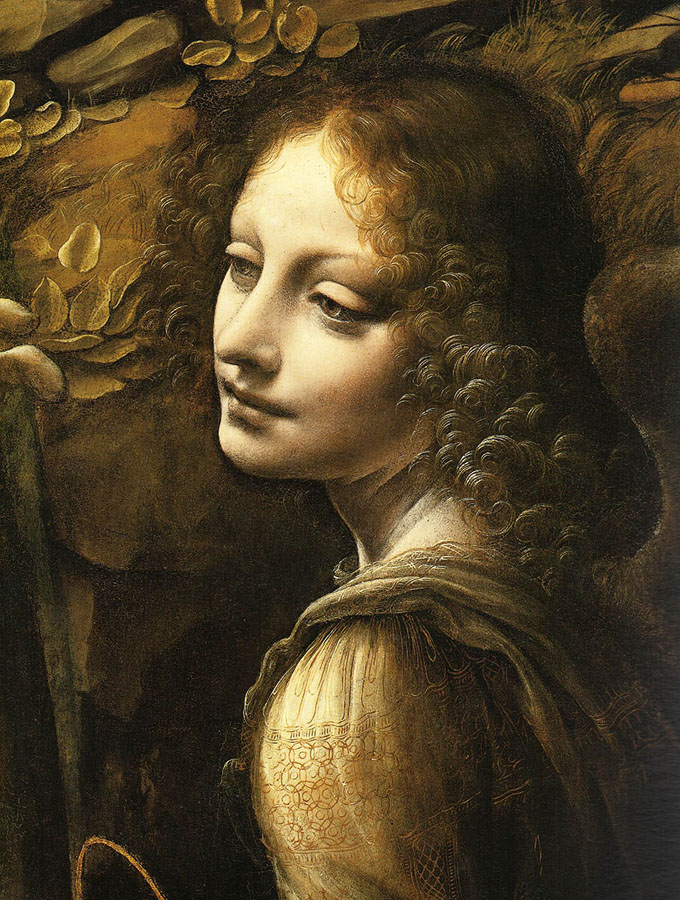
I love the rotation of this angel’s head and the delicate curls in his hair. Young face appears androgynous with large, serene eyes, full lips and a narrow chin. The clothing is also more elaborate than in the Louvre version with intricate pattern running across the shoulder and body. Fused with the body, grey-brown wings have no color layers left but feel very real nonetheless.
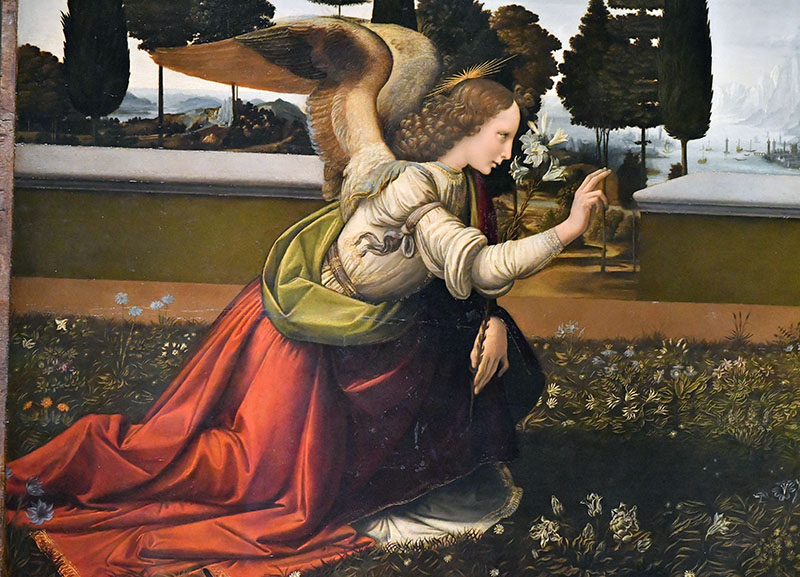
Botticelli (1445-1510), Italian
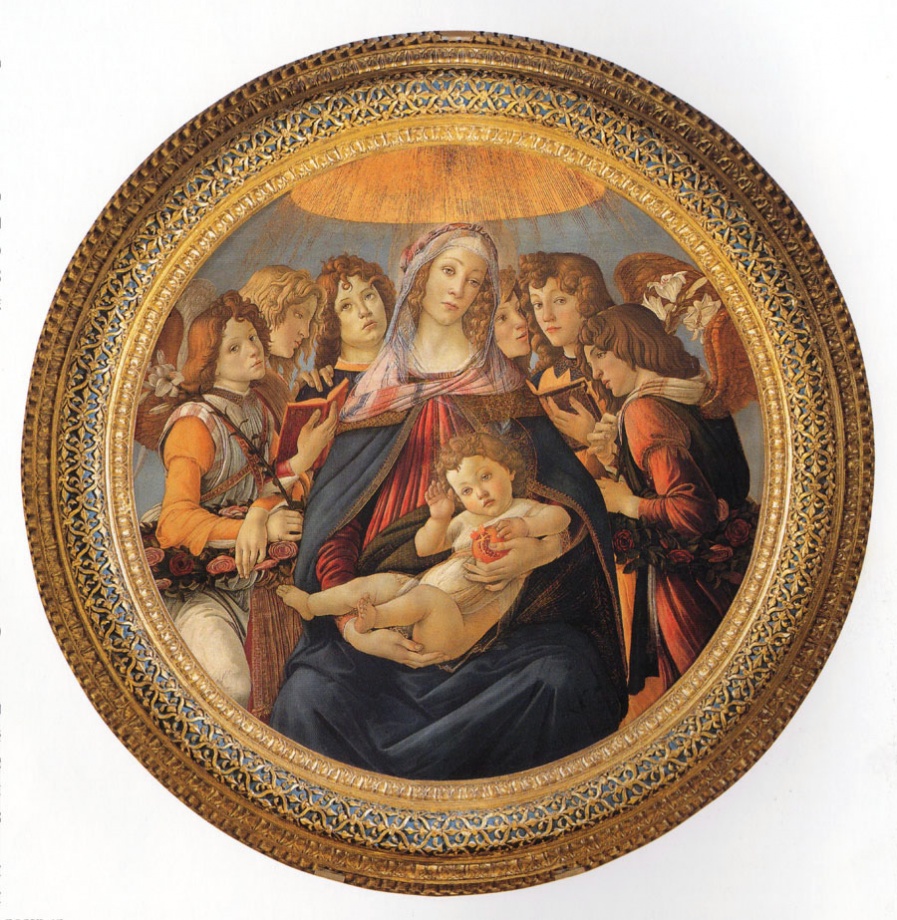
Italian artist, Sandro Botticelli was born in Florence. He trained in the workshops of Filippo Lippi and Verrocchio – two prominent Italian artists. Botticelli met young Leonardo da Vinci in the Verrocchio’s workshop and while their art styles are different, all these artists (Botticelli, Lippi, da Vinci, Verrocchio) have a few things in common, such as thoughtful compositions, great anatomy skills, graceful position of figures, painting of wavy hair and realistically painted fabric. Like most artists, Botticelli produced religious art for churches and prominent families. The frame for this painting consists of blue-gold lilies – the symbol of Florence where he worked most of his life.
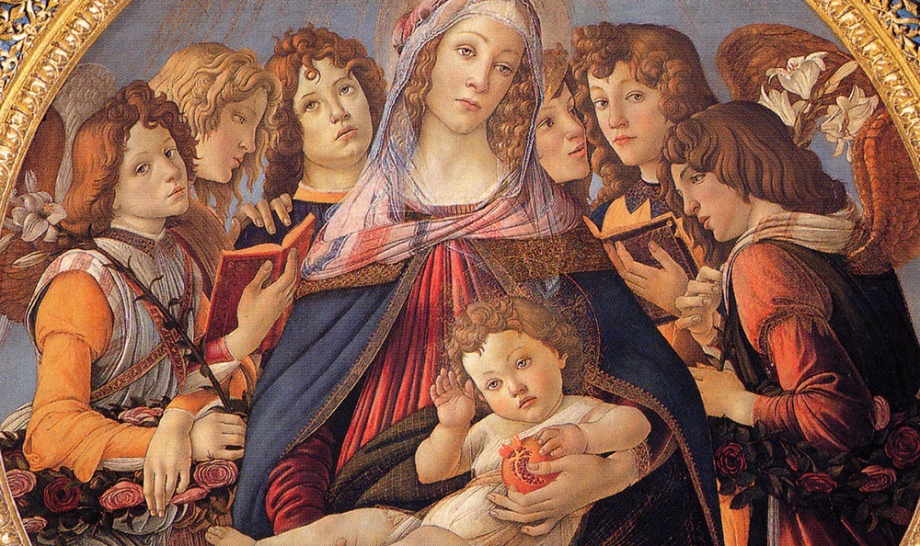
When we look at the artist’s body of work, we see no real difference in painted faces. Madonnas and Venus look about the same and even male faces appear very similar to the female ones. The skin tones also have a very limited color palette and hardly have any color temperature shifts from warm to cool that artists often use to paint the skin realistically. He relies on graceful lines to describe the figures. This stylized, icon-like approach to painting portraits becomes his signature art style.
If Madonna gets up, her body is very tall in comparison to the surrounding angels. The baby’s body is also unnaturally large. It happened because some artists used the convex and concave mirrors in Flemish art, during the Renaissance and beyond (think 16th-century Mannerism). Artists used mirrors to see how to “compress” a large number of figures into a small, often round panel. This distortion magnifies the importance of Mary and child and also brings angels in a tight semi-circle around the main figures. The roses also have this unusual compression. Botticelli paints the angels with beautiful rotations of heads looking in different directions as they’re speaking to each other that makes this painting dynamic and naturalistic. Angels hold white lilies and roses – the symbols of Mary’s purity. The Pomegranate is a symbol of Resurrection (Source: The Great Masters of European Art, Franci, p.109).
Vernet (1789-1863), French
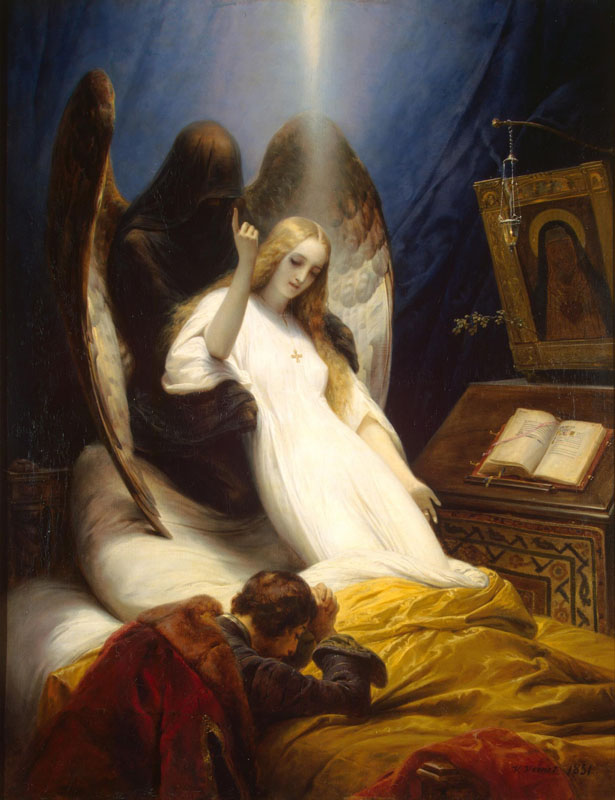
French artist Vernet doesn’t belong to the league of top artists. He mostly painted battle scenes disliking Academic painting. This oil painting is very different from his other works. I love the glow emanating from the female figure taken away by the dark angel behind her. Young woman almost slides into the angel’s hands. She is painted at a diagonal to create dynamic composition fitting the praying man by her death bed.
Thayer (1849-1921), American
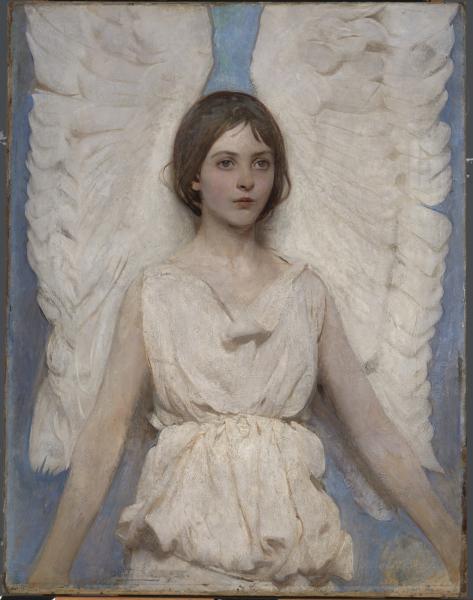
You can find Abbott Handerson Thayer’s art at the Smithsonian museum in Washington D.C. He painted a lot of angels using family as his inspiring models. This is a portrait of his daughter Mary. I like how free his painting feels. Painterly and unfinished on the edges, the figure uncrosses her arms creating a triangle – a widely used composition in Renaissance art. Covered in white robe, this beautiful angel has ethereal facial expression that’s neither dramatic nor too sweet. White wings are so soft, I want to reach out to touch them. This painting looks very contemporary rooted in traditions of classical painting.
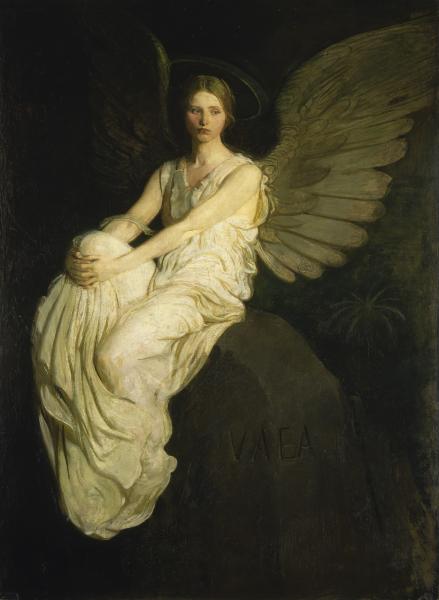
“Apart from the title, our only clue to the subject of this work is the inscription “VAEA,” the name of the mountain in Samoa where Robert Louis Stevenson is buried. Stevenson’s poetic tales of men at war with themselves had dazzled Abbott Handerson Thayer, whose own life was marked by exaltation and despair. And, like the Scotsman’s most memorable characters, the Stevenson Memorial carries a hidden story. Underneath this image is an earlier composition, a portrait of Thayer’s three children that he had painted as a tribute to Stevenson’s A Child’s Garden of Verses. But Thayer painted over this with the figure of an angel to convey a more encompassing, personal grief. The artist’s wife had died in 1891, and his many paintings of angels created thereafter suggest the mysteries of life, death, and the fate of the spirit.
The luminous angel shown here, seated at Stevenson’s tomb, is an emblem of memory, a light against oblivion. Just as Thayer’s love for his wife survived in the image of their children, Stevenson’s fame would live on in his works.”
Exhibition Label, Smithsonian American Art Museum, 2006
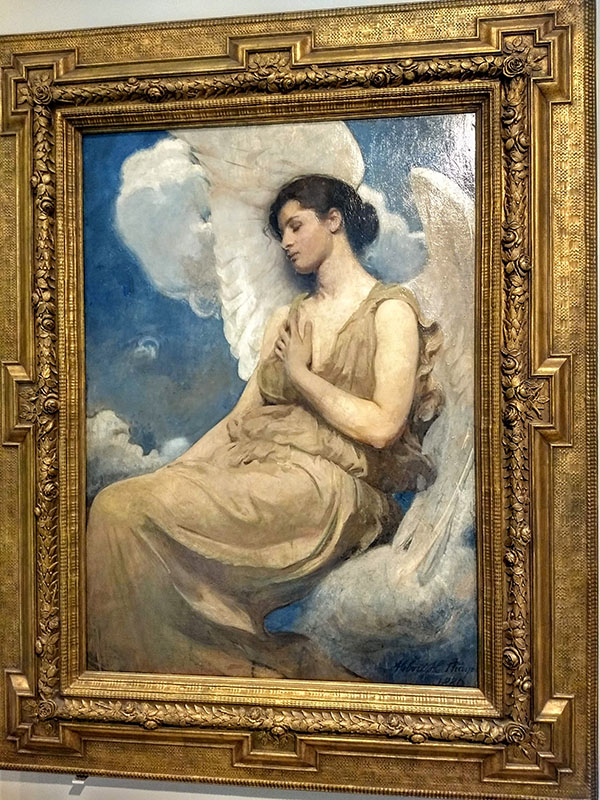
“I have put on wings probably more to symbolize an exalted atmosphere … where one need not explain the action of his figures.”
Canova ( 1757-1822), Italian
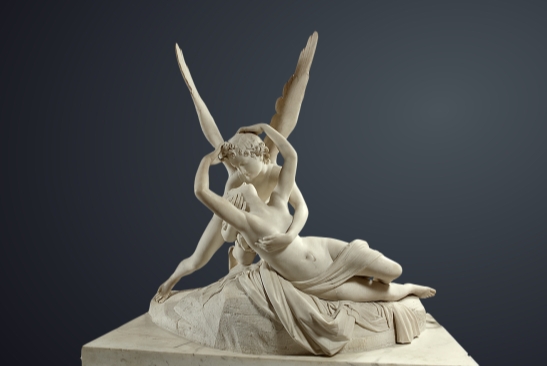
Incredibly talented Italian neoclassical sculptor, Antonio Canova created two versions of this sculpture. “Psyche revived by cupid’s kiss” are located in the Louvre and the Hermitage. (One of the copies is at the Met.) The artist captures Cupid, god of Love, in the moment of kissing lifeless Psyche waking her up.
According to the Roman writer Apuleius, Cupid’s mother, the goddess Venus, envious of Psyche’s beauty, sent her into the Underworld to get a vessel with Proserpina’s beauty ointment. Although Venus told Psyche not to open the bottle, Psyche did and fell asleep. Only the kiss of Cupid revived his lover.
Since ancient times Psyche has been depicted with butterfly wings. This is a reference to the dual meaning of her name, Psukhē, in Greek: soul and butterfly. Thus did the butterfly become the symbol of the immortality of the soul. The story of Psyche symbolizes the ordeals the soul must undergo in order to achieve happiness and immortality (Source: the Louvre | http://musee.louvre.fr/oal/psyche/psyche_acc_en.html).
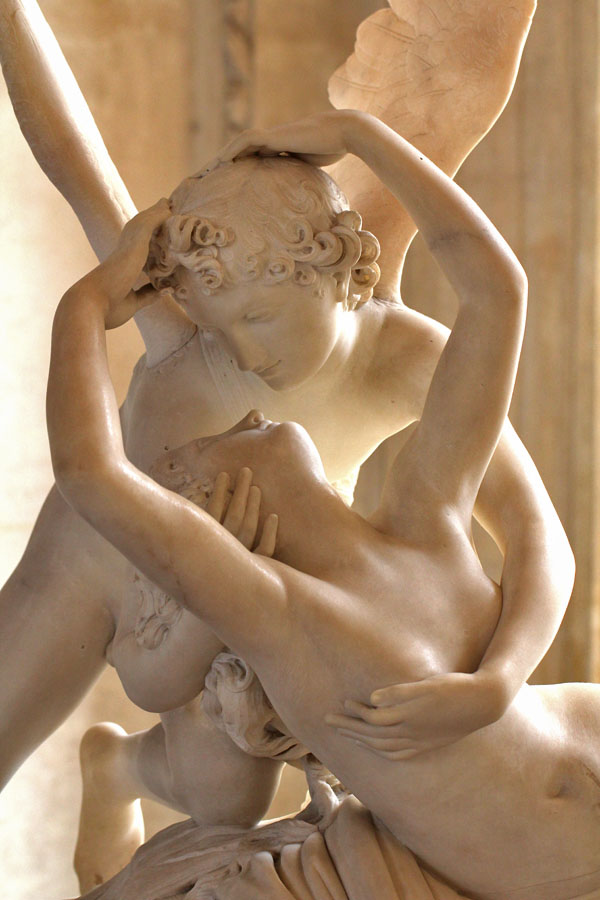
I love this sensual sculpture for highly artistic presentation on the theme of love. Two life-like figures interlock the arms creating a circular movement, asking the viewer to gaze at their perfectly carved, graceful figures. Clearly inspired by classical antiquity, Canova emphasizes line quality, balance and circular movement in his unique design. He creates brilliant composition where two marble figures interlock and rotate creating ascending triangle. This dynamic movement is characteristic for romanticism. (Images are taken from wikipedia & the Louvre museum websites.)
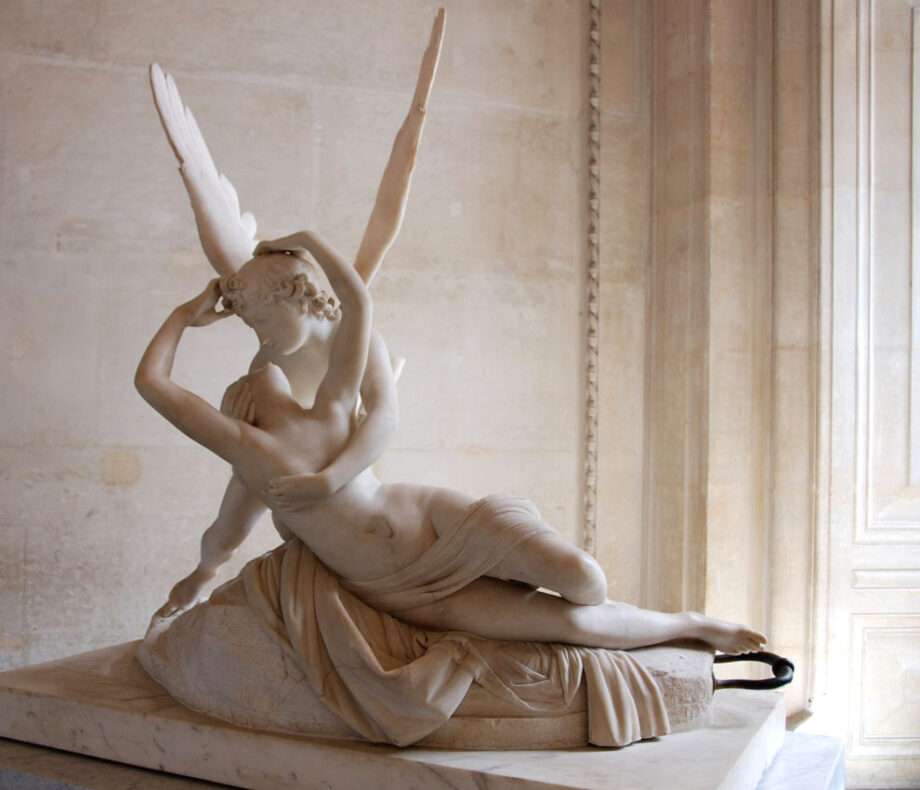
William-Adolphe Bouguereau (1825-1905), French
Bouguereau is one of my favorite painters for his unbelievable knowledge of anatomy in oil painting. Most contemporary realist artists study Bouguereau’ paintings, especially how he handled the depiction of skin tones. He captures figures with perfection and grace, reveling enormous undertaking in preparatory work. His compositions show thorough knowledge of classical art and revolve around diagonals, triangles and curving lines that let us enter and travel around the painting. There is perfection and balance between shapes, curves, and diagonals in every oil painting. The artist was prolific and hardworking, spending most of his time locked in the studio painting. He is often criticized for his lighthearted subject matter painting “boring” classical nudes and stories from Greco-Roman mythology. However, such critics don’t understand the artist’s unique talents in handling color, composition and human anatomy.
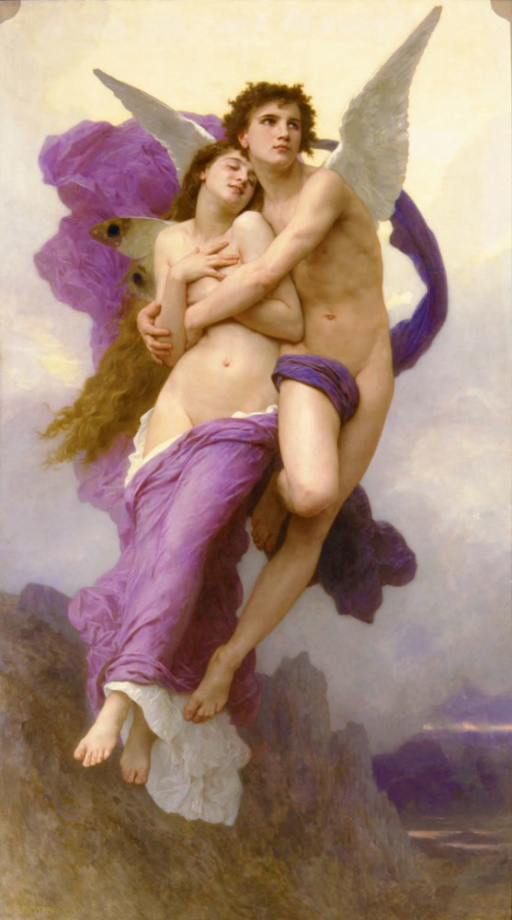
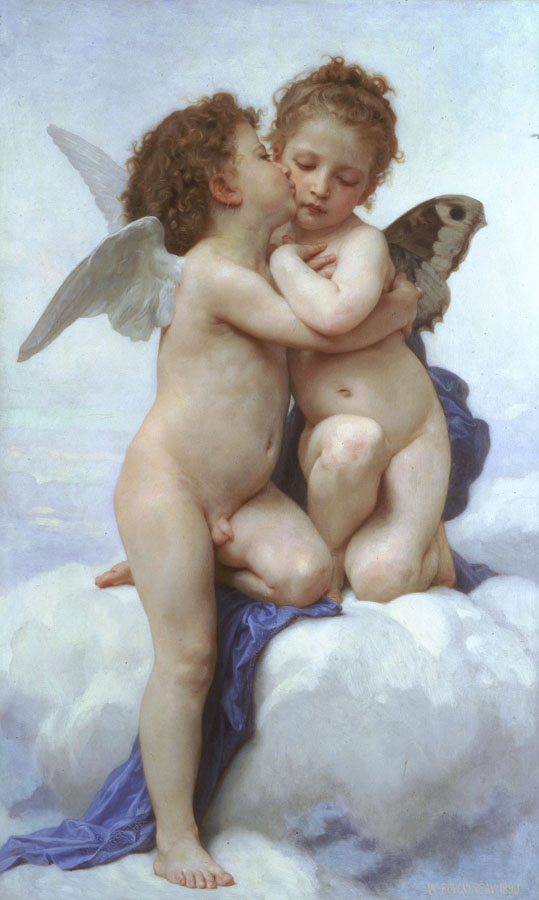
In the previous painting we see winged lovers flying across the sky. It’s not the only painting he created on the theme. For instance, in this painting William Bouguereau portrays Cupid and Psyche as very young children to highlight their innocence. In both paintings the butterfly wings adorn Psyche while Cupid has white, bird-like wings. In these paintings the artist creates dynamic compositions with movement and balance of every body part. This sensibility to beauty is rare to see in contemporary art.
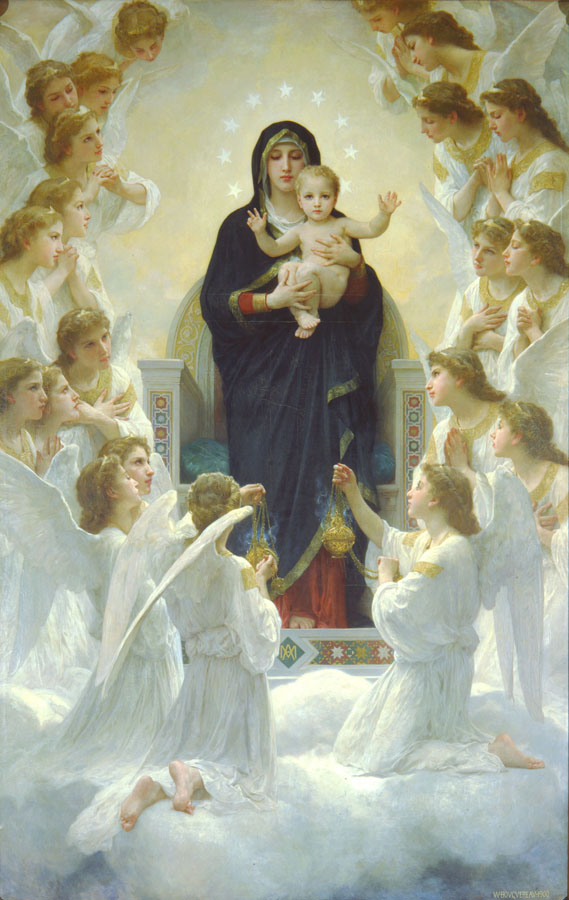
François GÉRARD (1770-187), French
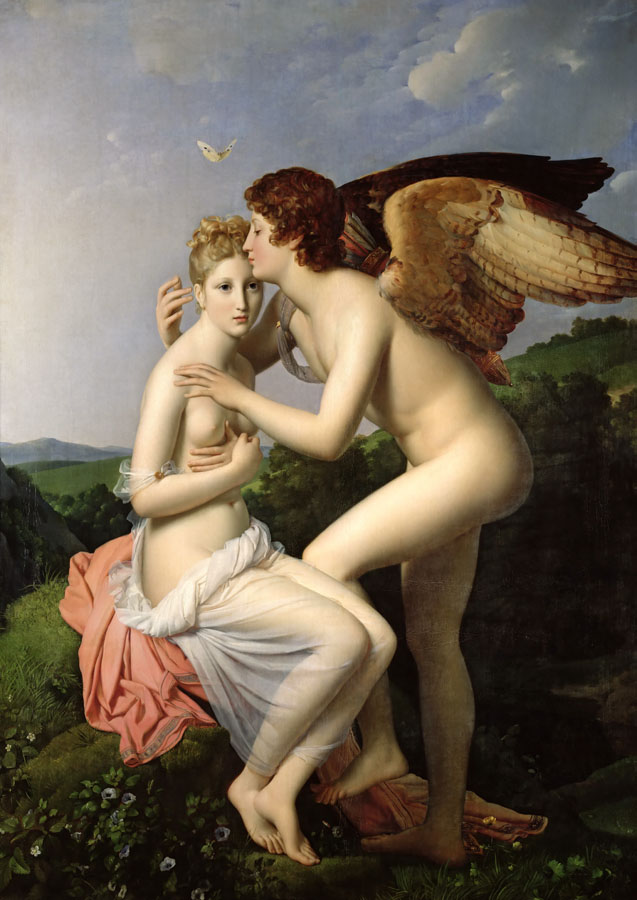
This neoclassical painting was completed by one of David’s students – Gerard. Neoclassical art is characterized by smooth, unseen brushwork, the perfection of human form and classical compositions. David was a father figure in the revival of classical painting that became the 19th century neoclassicism art movement.
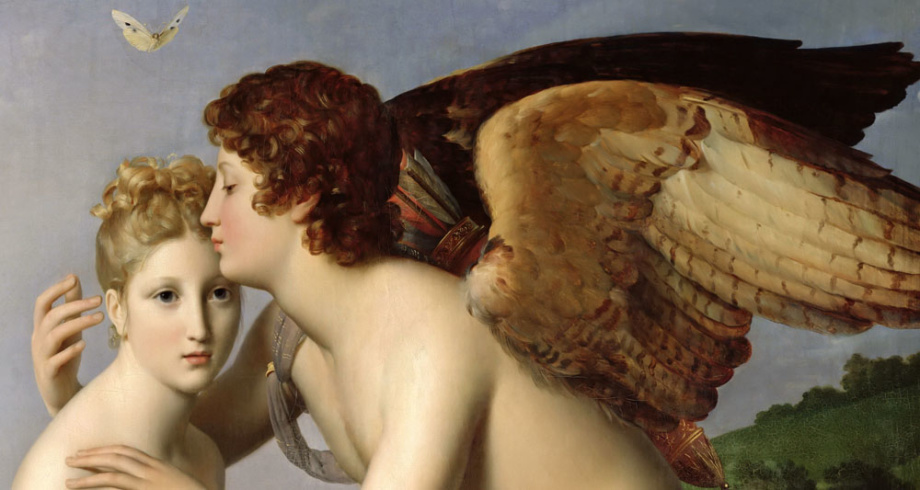
François Gerard gives his interpretation of the myth when yet unseen Cupid kisses Psyche surprising her. Both the butterfly (hence the butterfly wings in Bouguereau’s paintings) and the name Psyche means “soul”. So the artist depicts unity of the divine love and human soul (Source: De Vergnette François, Louvre).
I absolutely love the artist’s keen sensibility to depict a sensual touch. Cupid’s hand gracefully wraps around Psyche as he barely touches her. The perfection is in every part of this artwork – soft skin tones, balanced composition, perfect anatomy, realistic fabric, curly hair and beautiful wings, of course! This idealization of forms was criticized by the contemporaries but I think it was the very aim of the artist in his portrayal of pure love.
Raphael (1483-1520), Italian
Italian artist & architect, Raphael is the third artist of High Renaissance in Italy (Together with Michelangelo and da Vinci they formed the epitome of artistic excellence in the early 16th-century Italy). Raphael was a dashing young man who also had an easy going personality. Coupled with his talent, his persona helped him receive a constant stream of commissions from royalty including the two Popes. Raphael organized a large-scale workshop with numerous students and craftsmen fulfilling commissioned art. Although he died at the 37 years of age, he left an impressive artistic legacy, producing a large body of work with most of it located in the Vatican. Raphael incorporated the influences of his peers – da Vinci and Michelangelo to produce religious art and portraiture.
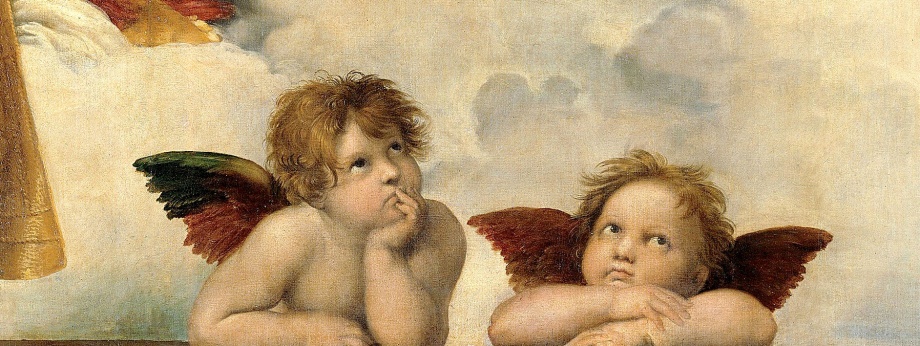
This is a closeup of the altarpiece commissioned by Pope Julius in 1512 that features classical, triangular composition with the Sistine Madonna and Child floating on the clouds and two kneeling saints below them. These two cherubs were painted at the very bottom of the painting and look very different from the rest. They’re bored and curious, and remind us of little kids rather than idealized, divine creatures.
Ca’ d’ Oro palace
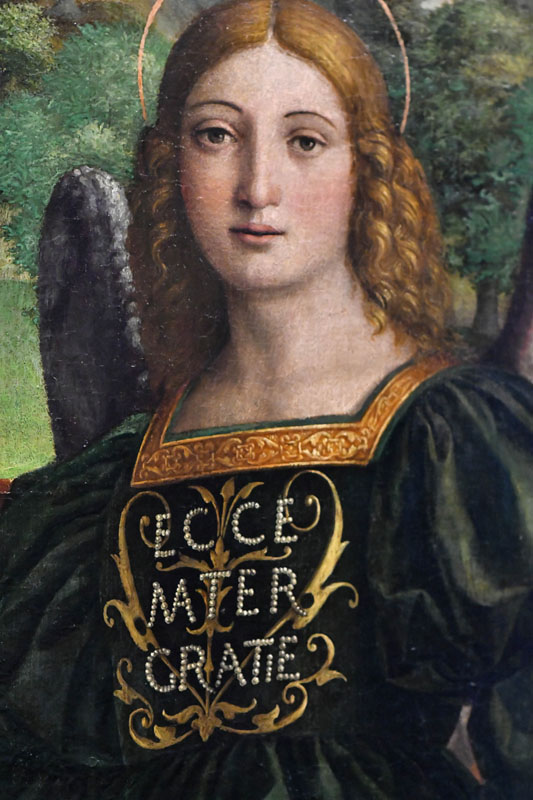
What I love about this painting that I photographed at the Ca’ d’Oro palace in Venice is the angel’s frontal position. The angel faces us and it almost feels like he is going to speak to the viewer.
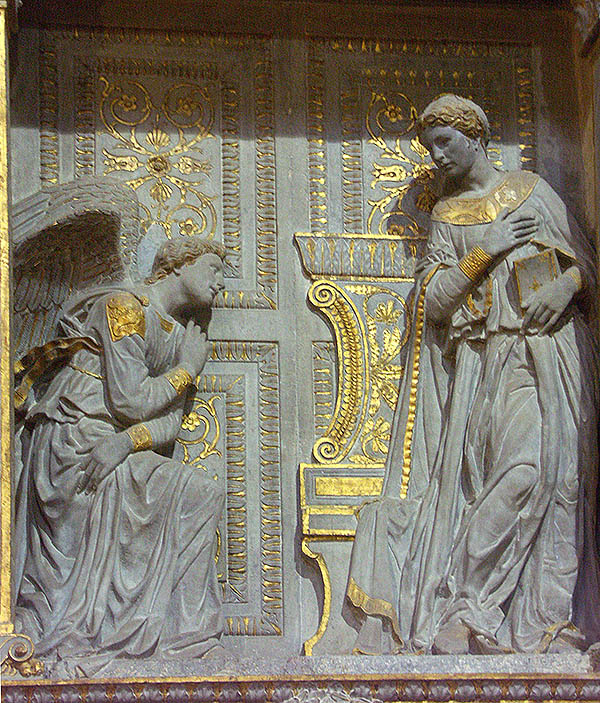
John Duncan 1866-1945, Scottish
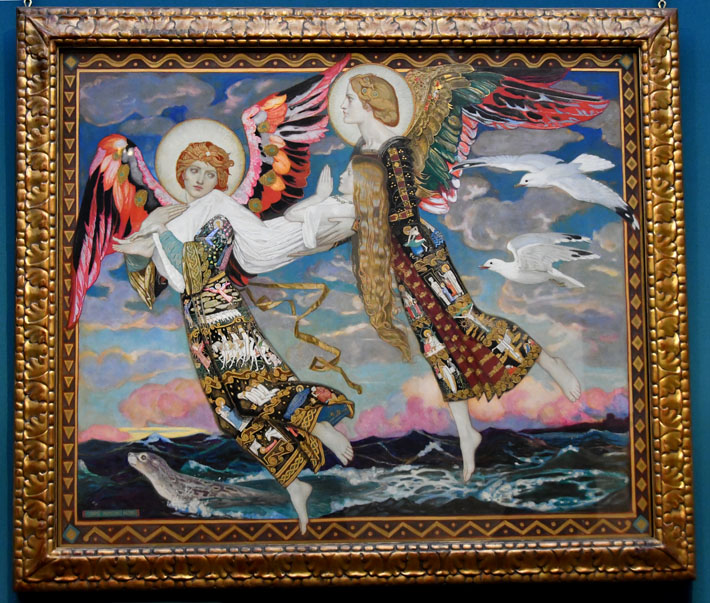
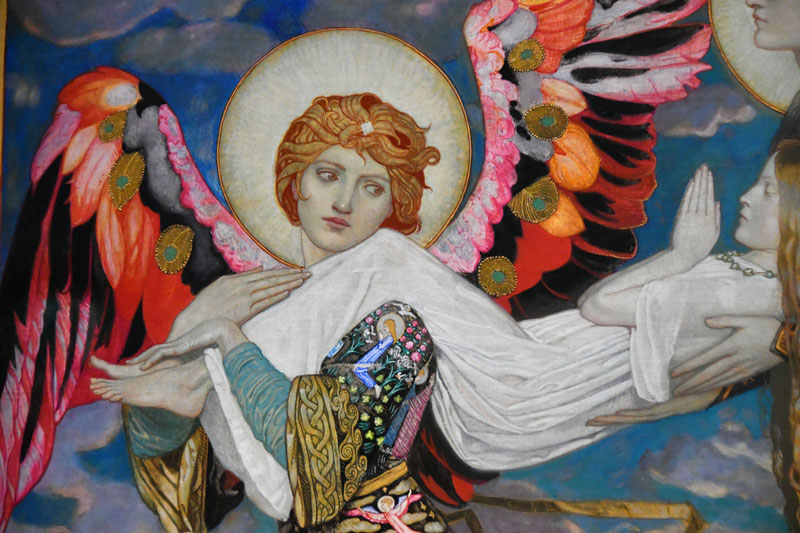

Duncan studied art in Scotland, England and Belgium to settle in Edinburgh in 1892. The artist represents the Celtic Revival movement in Scottish art and his illustrative style looks innovative even today. This colorful painting looks like it’s made of collaged pieces as religious symbols, and even the ornate frame mimic’s the artist’s unique style.
“According to the legend of the Irish Saint Bride she was transported miraculously to Bethlehem to attend the nativity of Christ. Here two angels carry the white robed saint across the sea. The seascape reflects Duncan’s fascination with the Outer Hebrides and the Isle of Iona. The birds and seal provide an effective naturalistic foil for the supernatural angels overlapping the patterned border. Scenes from the life of Christ decorate the angel’s robes, and may include the artist’s self-portrait as the tiny clown (a holy fool) accompanying the procession of the magi on the leading angel’s gown. ” (Source: Scottish National Gallery)
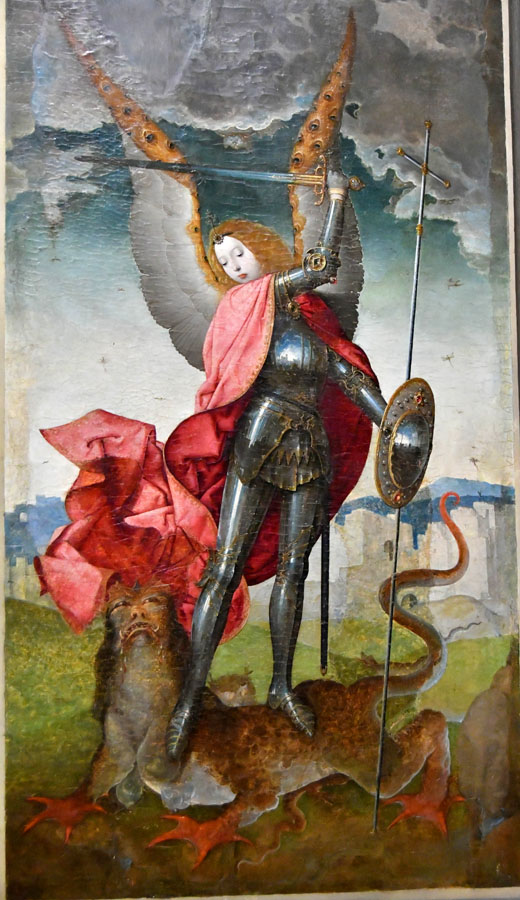
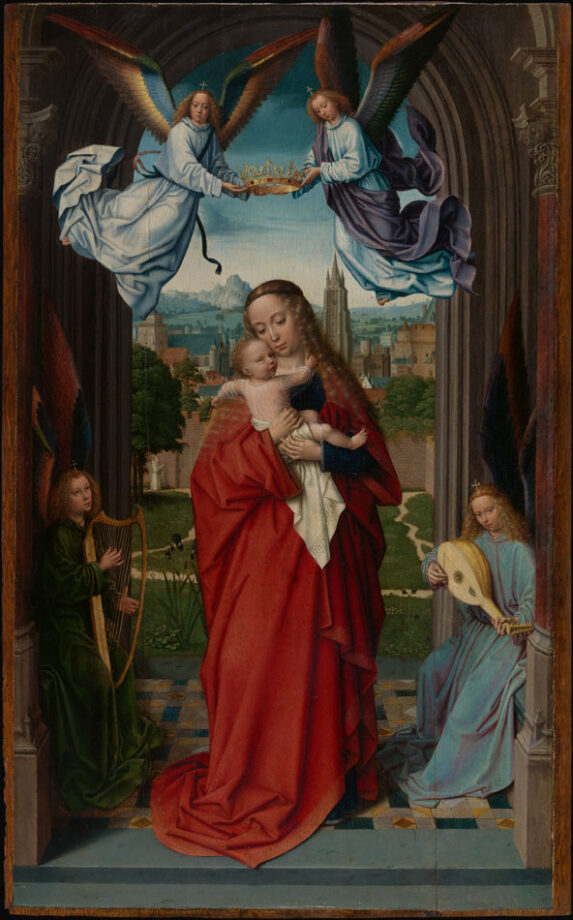
“Gerard David, the leading painter in Bruges in the late fifteenth century, followed the legacy of Jan van Eyck. In this painting, he has taken the Virgin and Child from his predecessor’s well-known Virgin and Child at the Fountain, but modernized the composition by placing the figures in a grand arched porch flanked by columns with Italianate capitals, against the skyline of contemporary Bruges. A Carthusian monk is seen strolling and reading in the enclosed garden, suggesting that the painting was linked to the former monastery at Genadedael, just outside the city walls of Bruges.”-description taken from the Met
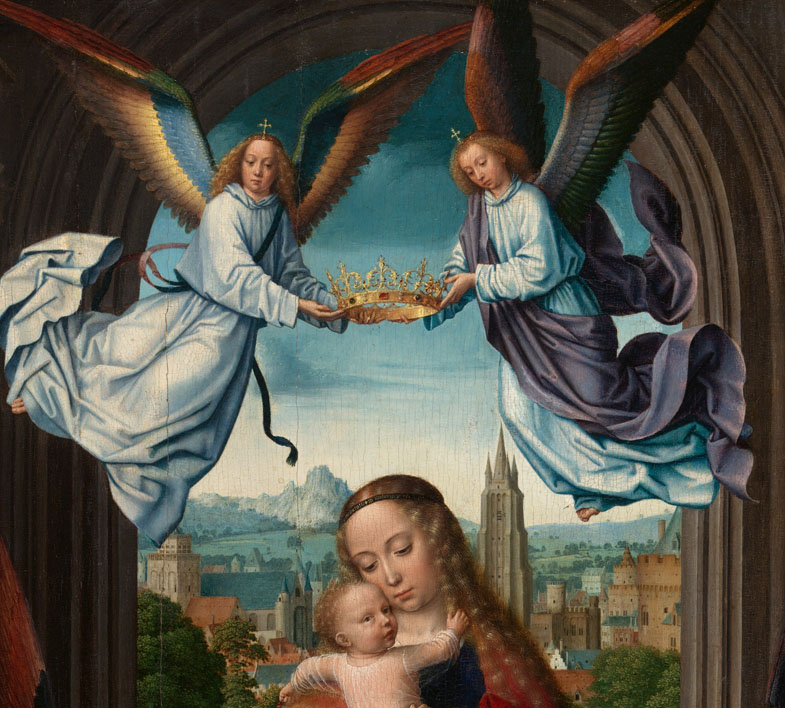
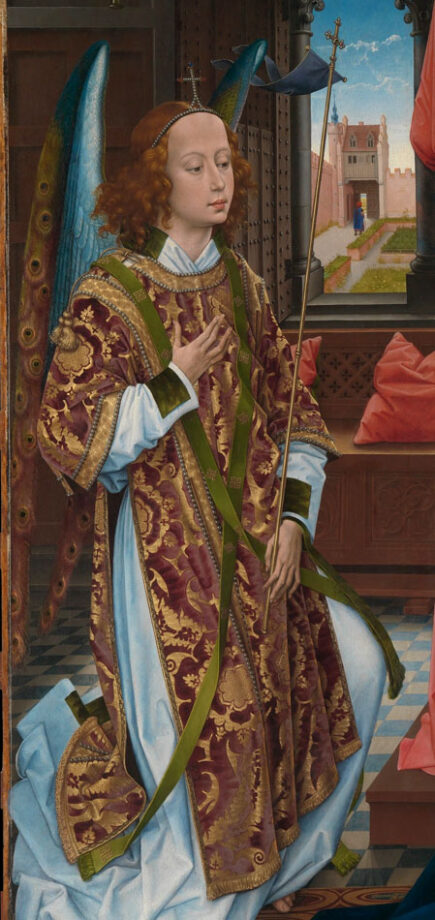
Hans Memling painted realistic textures and details in a similar style of van Eyck. The composition is based on a design by Rogier van der Weyden where he probably was an apprentice before establishing himself in Bruges in 1465.
My art inspired by paintings of angels
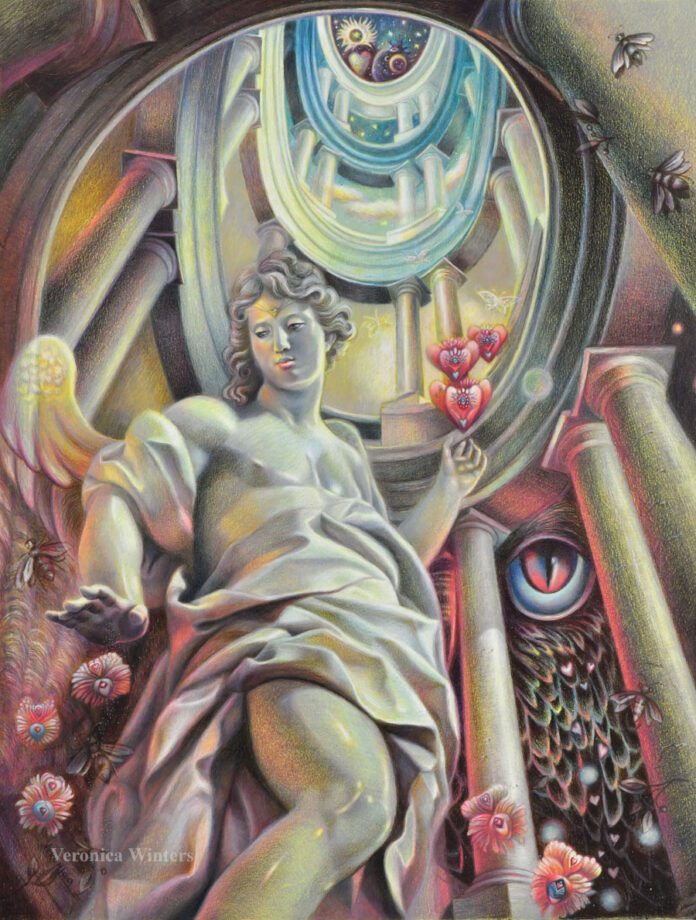
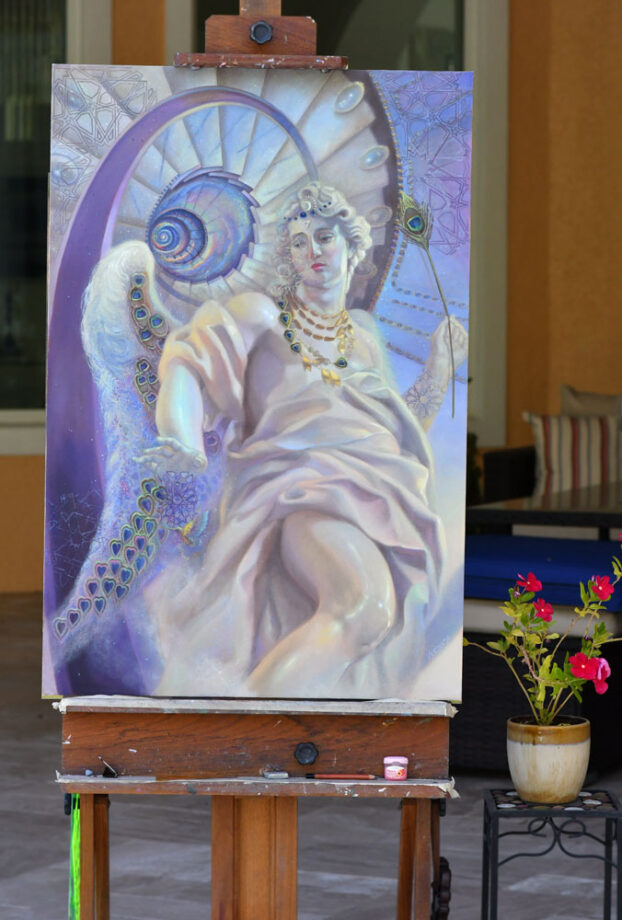
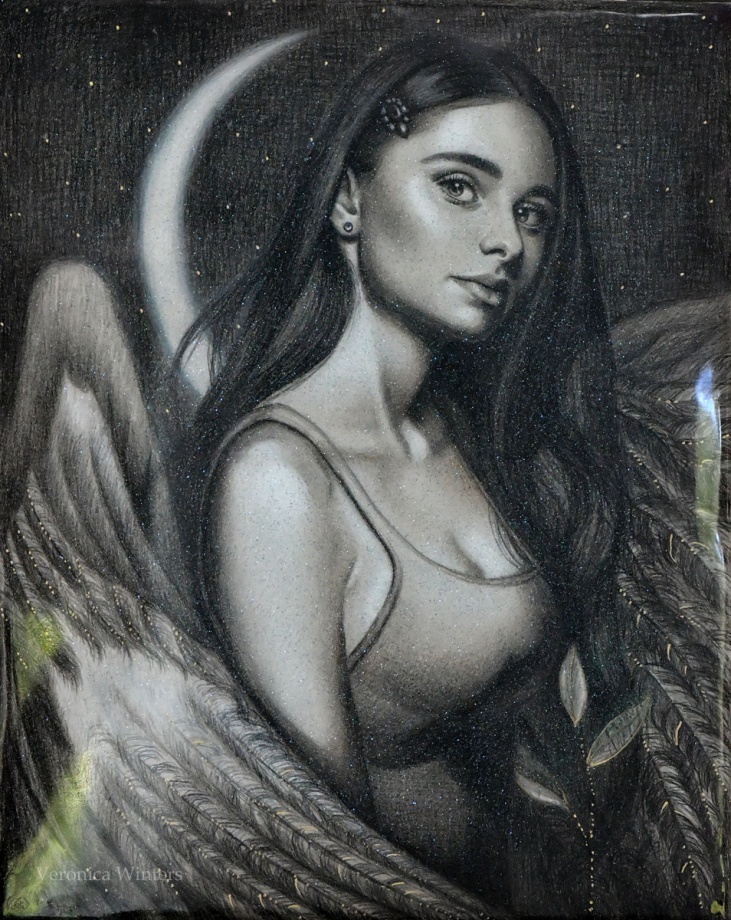
Check out all visionary art for sale
Did you like these paintings of angels? What is your favorite? Do you have other paintings of angels that you love? If you love this article, share it on social media. So more people see beautiful art.
All art is copyrighted by respective artists and museums. All art is used for educational purposes only.
